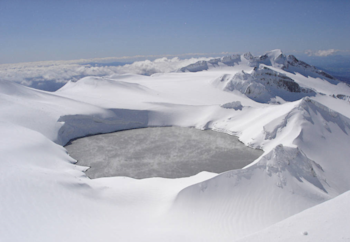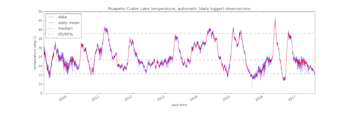
Mount Ruapehu Crater Lake (Te Wai-a-Moe) under the microscope
Now the snow has arrived it's time to check out the volcano hazards on the way to the ski field
The snow has arrived at Mount Ruapehu over the last week or so. This means it is time to drag out the skis or snow board and head for the slopes. As you check the weather forecast and road conditions it is also a good time to remind ourselves about the volcano, its active crater and lake (Te Wai-a-Moe). What are the hazards, how do I prepare for them and what is the volcano up to?
Although it is now almost 10 years since the last eruption from the Crater Lake (Sept 2007), Mount Ruapehu remains one of our most active volcanoes. Small eruptions only affect the summit plateau around the Crater Lake, however the larger ones can generate lahars down the slopes. These larger, lahar generating eruptions occur on average about once every 7 years and can impact the ski fields. So, remembering Ruapehu is an active volcano, it is a good idea to check out the hazard information before heading to the skifields. There are hazard posters and video clips you can check out.
GeoNet monitors Ruapehu volcano and its Crater Lake. The monitoring includes seismic, acoustic, GPS sensors around the volcano, gas flights and sampling of the Crater Lake. The temperature and water level of the lake are also monitored by datalogger. Crater Lake is now cool, currently the lake temperature is 19 °C. The temperature of the lake typically ranges from over 38 °C to less than 16 °C.
An analysis of the lake temperature data since 2009 when we installed a datalogger shows that for 5% of the time it is warmer than 38 °C and another 5% it is less than 16 °C. The median temperature is 24 °C. Looking at the longer term Crater Lake temperature data, collected from lake visits since 1950, the behaviour is similar. Those data show that for 5% of the time it is warmer than 47 °C and another 5% is cooler 14 °C. The higher temperature reflects the volcanic unrest and eruptive activity of the 1960’s-1980’s. The median temperature was 28.0 °C.
Research on the eruptive history of Ruapehu through the Crater Lake has shown that the probability of an eruption increases when the lake is significantly warmer or cooler than the median temperature range. Eruptions have been significantly more frequent when the lake was hot rather than cold. Despite the current lower lake temperature, the likelihood of an eruption remains low: in the 10 years since the last eruption the lake has cooled seven times to below 16 °C and heated six times to over 38 °C with no eruptions.
The GeoNet monitoring of the volcano and Crater Lake does however indicate the volcano is alive. The gas flights continue to record volcanic gases (CO2 has ranged 100-1800 tons/day, while SO2 has ranged 50 to 200 tons/day during the last 5 years). The primary chemical indicators show there are as less volcanic fluids present. The seismic energy is also low at Ruapehu, with very little volcanic tremor being present.
GeoNet continues to monitor as it always has. Sounds like it is a good time to go ski an active volcano, but don’t take your eye off it and remember what to do should you hear the sirens (go to higher ground if in a valley).




